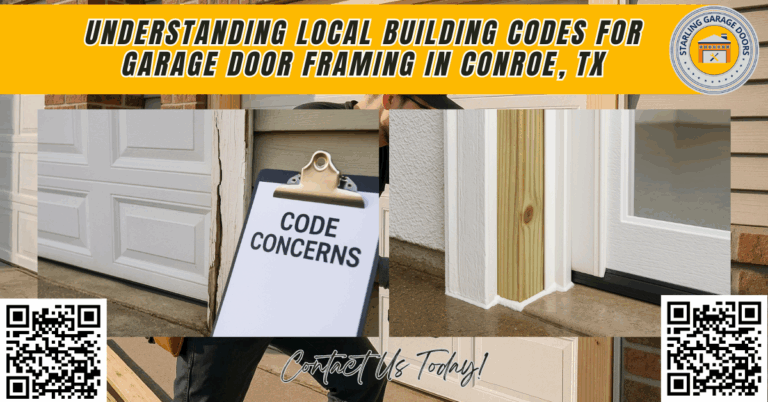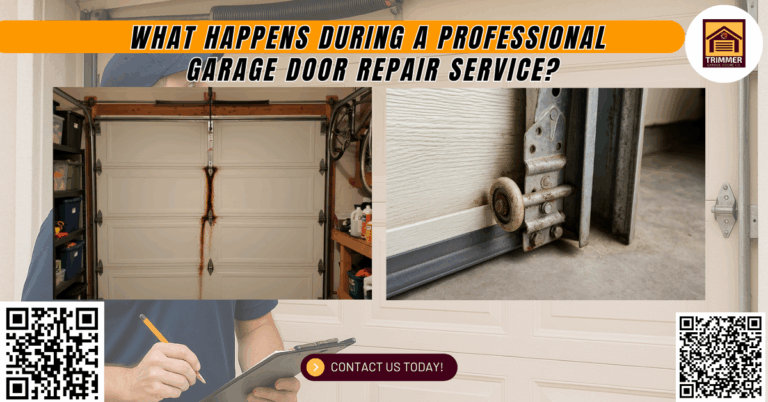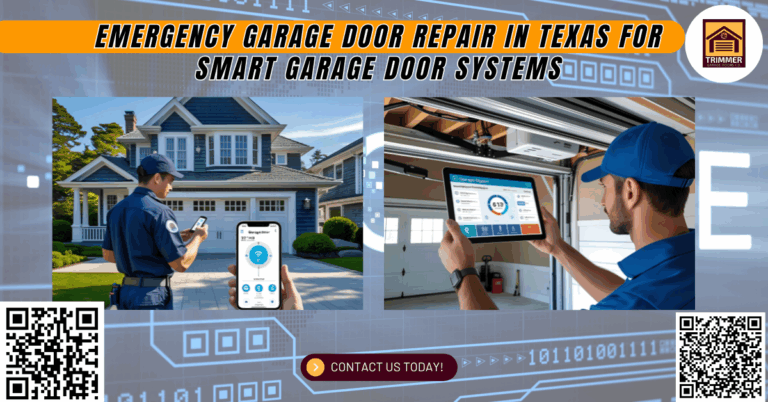Not long ago, a homeowner in Killeen, TX, reached out to Trimmer Garage Doors Co. after coming home from a long weekend only to find their garage door stuck halfway open. It turned out the issue was a snapped torsion spring, a part that had worn out after years of neglect. This is a situation we see multiple times a year, and it highlights a major problem: most homeowners don’t realize how critical garage door maintenance is until something breaks.
Statistically speaking, garage doors open and close an average of 1,500 times a year. That’s thousands of up-and-down cycles involving moving parts like rollers, hinges, cables, and springs, all of which are under constant tension. Without regular maintenance, these components can deteriorate, leading to major malfunctions that may compromise the door’s safety and performance.
At Trimmer Garage Doors Co., we believe that preventative maintenance is the first step to avoiding costly garage door repairs and ensuring quiet operation. In this complete guide, we’ll break down everything homeowners need to know about garage door maintenance, from essential tasks and safety tips to professional services and seasonal checklists. Whether you have a sleek steel door with modern features or a traditional wood garage door, this article is for you.
Why Garage Door Maintenance Matters
Garage doors aren’t just about curb appeal; they are essential to the daily function and security of your home. A properly maintained garage door system ensures smooth operation, prevents accidents, and extends the life of your investment. With multiple moving parts, including the garage door opener, rollers, springs, and tracks, all components must be working together efficiently.
Without regular maintenance, wear and tear accumulate, leading to problems like bent tracks, frayed cables, or broken garage door springs. These issues not only affect performance but also compromise safety features like the auto-reverse mechanism. Routine checks and timely lubrication with the right lubricant, such as white lithium grease or a silicone spray, help avoid corrosion, reduce noise, and ensure every part operates as it should.
By performing preventative maintenance throughout the year, you save time and money in the long run. It also ensures your family’s safety and peace of mind, knowing that the largest moving door in your home is functioning correctly.
Components That Need Regular Attention
Garage doors are intricate systems made up of many essential components. Understanding these parts and their functions is the first step in performing proper maintenance. The garage door springs, either torsion or extension, carry the door’s weight and allow for controlled opening and closing. If a spring breaks, it can cause sudden, dangerous movement, making it critical to inspect them regularly.
The garage door tracks and garage door rollers work together to guide the door during operation. Over time, debris and dirt can build up on the tracks, or rollers can wear down, leading to jerky or loud movement. Regular cleaning and lubrication help maintain smooth operation and reduce strain on the opener.
The opener, whether it’s a chain-drive, belt-drive, or smart garage door opener like the Stealth Drive Connect, is another vital part. Issues with the door opener motor or power source can result in doors that won’t move at all. Keep an eye on the arm bar, top rail, and release handle, and test the automatic opener and sensors for proper functionality.
Hinges, roller brackets, and cables also experience wear and should be examined for rust, loose bolts, or fraying. Using a socket wrench to tighten bolts and nuts and applying spray lubricant on metal parts helps prevent rust spots and corrosion. All these parts, working in harmony, contribute to a reliable and quiet garage door system.
Signs Your Garage Door Needs Maintenance
Garage door problems often start small, but if left unchecked, they can quickly escalate. One of the first signs to watch for is unusual noise. A well-maintained door should operate with minimal sound. Grinding, squeaking, or popping could indicate that parts like rollers or hinges need lubrication or replacement.
Another red flag is when the door operates unevenly or gets stuck midway. This can be a sign of worn garage door springs or misaligned tracks. Also, if the door doesn’t stay open halfway when you disconnect the opener using the release handle, the balance may be off, a dangerous situation that requires professional attention.
Watch for visible wear and damage, too. Frayed cables, rust spots on steel components, or bent garage door tracks are all indicators that maintenance is overdue. Also, pay attention to the weatherstripping around the door; cracked or missing weatherstripping can lead to water damage or energy loss.
Finally, test the door opener regularly, including safety features like the auto-reverse function. Place a small object under the door and attempt to close it. If it doesn’t reverse immediately, the sensors may be dirty or misaligned. Addressing these signs promptly can prevent costly breakdowns and enhance overall door safety.
Monthly Garage Door Maintenance Checklist
Performing simple maintenance tasks every month helps keep your garage door in peak condition. This monthly checklist is designed as a step-by-step guide for easy DIY maintenance that doesn’t require special tools or experience.
1. Visual Inspection: Start by examining all garage door parts. Look at the springs, cables, hinges, rollers, tracks, and weatherstripping. Check for any signs of wear, damage, or rust. If you spot a problem, take note and address it or schedule professional service.
2. Listen to Operation: Open and close the door a few times. Pay attention to the sound. Grinding or squeaking often means the moving parts need lubrication. A quiet operation usually means everything is running smoothly.
3. Lubricate Moving Parts: Apply garage door lubricant or white lithium grease to metal parts including the rollers, hinges, and springs. Avoid greasing plastic parts or the tracks. Spray lubricant prevents rust and ensures smooth operation.
4. Test the Balance: Disconnect the door opener by pulling the release handle. Lift the door manually to the halfway point. If it stays in place, the balance is good. If it falls or rises, the springs may be off-balance and should be adjusted by a technician.
5. Test Safety Features: Ensure the door’s auto-reverse feature works. Place a roll of paper towels under the door and close it. If the door doesn’t reverse immediately upon contact, clean the sensors and test again. Also, check the sensor alignment and power connection.
6. Clean Tracks: Use a cloth or vacuum to remove debris from the garage door tracks. Avoid applying grease to the tracks, as this can attract more dust. Instead, ensure the tracks are clean and aligned for the rollers to glide smoothly.
This checklist takes about 20 minutes but helps prevent big problems later. It’s the kind of proactive care that Family Handyman recommends as part of a healthy home maintenance routine.
Seasonal Garage Door Maintenance Tips
Seasonal changes in temperature and weather conditions affect garage door operation. Here are maintenance tasks broken down by season to help protect your door year-round.
Spring
Spring is the ideal time to refresh your garage door after winter. Check for rust spots on steel doors and hinges caused by moisture or salt residue. Inspect the garage door opener’s features and sensors to ensure they function properly.
Tighten bolts with a socket wrench and inspect springs for signs of wear. Spray lubricant on all moving parts, especially garage door rollers and hinges. Spring is also a great time to update weatherstripping and look for water damage in wood doors.
Summer
Heat and humidity can affect the door’s lubricant and weaken garage door springs over time. Lubricate the hinges and springs with a spray designed for high temperatures. Check the automatic opener for any signs of overheating or delayed response.
Vacuum the tracks to remove dust buildup and make sure the opener’s power source is stable. Summer is also a good time to inspect the rollers for damage from increased use during family activities and home projects.
Fall
Fall maintenance prepares your garage for colder weather. Clean out the garage door tracks thoroughly and inspect the bottom seal for cracks or gaps. Replace damaged weatherstripping to maintain insulation and keep out rodents.
Check all safety features before winter, including the auto-reverse mechanism. Apply lubricant to prevent metal parts from seizing during colder months. Take the time to test your garage door multiple times to ensure consistency in operation.
Winter
Cold weather can freeze metal components or make grease too thick. Use a silicone-based garage door lubricant or white lithium grease for smooth performance. Avoid standard grease, which can harden and cause the door to stick.
Inspect and clean sensors to make sure they’re not blocked by snow or debris. Make sure the power supply to your garage door opener is protected from outages or surges. Finally, run a complete system check: open, close, reverse, and balance.
What You Shouldn’t Do Yourself
While many maintenance tasks are safe for homeowners, some repairs should be left to the professionals. Attempting to fix high-tension parts like torsion springs or cables can result in serious injury. These components store a lot of energy and require the right tools and training to handle.
Likewise, electrical work involving the garage door opener or its sensors should only be performed by a technician. Miswiring or incorrect installation can damage the opener or lead to failure of safety features. Never attempt to realign or replace rollers or hinges attached to the top rail without understanding the door’s weight distribution.
Using the wrong lubricant or greasing the wrong parts can also lead to operational issues. Avoid greasing the tracks, as this can cause buildup and obstruct the rollers. Always follow a trusted DIY guide or consult experts when in doubt.
Your safety and your family’s protection are worth the cost of professional service. When in doubt, call Trimmer Garage Doors Co. for expert advice or on-site service.
Benefits of Professional Garage Door Maintenance
Scheduling professional garage door maintenance ensures that every component is thoroughly inspected and tuned for optimal performance. Certified technicians have the tools and knowledge to identify hidden issues that may not be obvious during DIY checks.
Professionals can perform tasks that are difficult or unsafe for homeowners, such as adjusting springs, replacing cables, or realigning tracks. They can also ensure that your garage door opener features, including the auto-reverse function and safety sensors, are calibrated correctly.
Regular service appointments often include a full lubrication of all metal parts, tightening of bolts and hinges, inspection of the arm bar and roller brackets, and a detailed review of the system’s operation. This kind of comprehensive care extends the life of your door by many years.
Most importantly, professional maintenance helps avoid sudden breakdowns that could leave your car stuck or compromise your home’s security. Trusting experts also preserves warranties and ensures the job is done right the first time.
Final Thoughts
Garage door maintenance might not be the most exciting home task, but it’s one of the most important. Just like changing the oil in your car or cleaning out the gutters, taking care of your garage door saves time, money, and hassle down the line. From applying the right lubricant to testing the safety features, every step contributes to a safer and more reliable door.
For homeowners in Killeen and the surrounding areas, Trimmer Garage Doors Co. is here to help. Whether you need a seasonal tune-up or urgent repair, our team provides dependable, professional service you can count on.
How Can Trimmer Garage Doors Co. Help You?
At Trimmer Garage Doors Co., we know garage doors inside and out. From rollers and tracks to smart openers and torsion springs, our technicians are trained to handle all types of garage door issues. Whether you have a residential home or commercial property, we provide top-tier service to ensure your door runs smoothly and safely.
- Full inspections and preventative maintenance
- Repairs for broken springs, cables, hinges, and tracks
- Smart opener installations, including Stealth Drive Connect
- Emergency service and friendly local support
Visit us at:
1000 E Central Texas Expy, Killeen, TX 76541
Call today: (430) 300-0733
Let Trimmer Garage Doors Co. keep your garage door in top shape, so it always opens when you need it most.
Frequently Asked Questions (FAQs)
1. Can I use WD-40 on my garage door parts?
No, WD-40 is a solvent and not a lubricant. It can strip away protective grease. Use white lithium grease or silicone-based spray instead.
2. How long do garage door rollers typically last?
Nylon rollers can last 10–15 years, while steel rollers may last longer but are often noisier without regular lubrication.
3. Should I unplug my garage door opener during a power outage?
Not necessarily, but using a surge protector is a good idea to protect the motor from voltage spikes once power returns.
4. How can I make my garage door quieter?
Lubricate all metal parts, replace worn-out rollers with nylon ones, and ensure the opener is properly mounted with vibration-reducing brackets.






